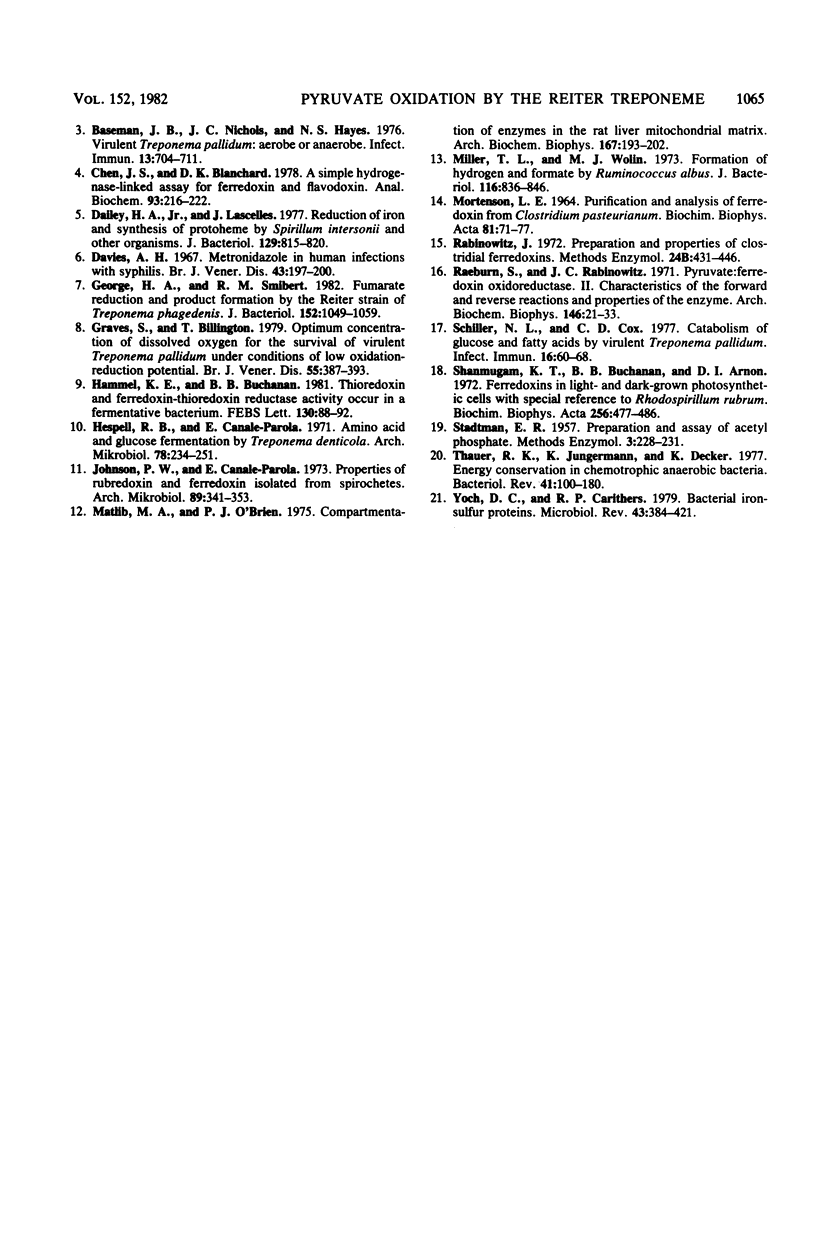Abstract
Spectrophotometric assays of pyruvate oxidation catalyzed by extracts of the Reiter strain of Treponema phagedenis indicated that viologen dyes, flavin nucleotides, and a ferric iron chelate, but not pyridine nucleotides, were utilized as electron acceptors. Benzyl viologen-linked activity partially sedimented during ultracentrifugation and appeared similar to clostridial pyruvate:ferredoxin oxidoreductase with respect to the spectral properties of the enzyme chromophore. Electron carrier activity in treponemal extracts was quantitated by a metronidazole-linked assay in which the oxidation of pyruvate by carrier-depleted extracts led to the reduction of electron carrier in the crude extracts which then reduced metronidazole. The rate of metronidazole reduction was proportional to the amount of electron carrier present in the assay. Electron carrier activity in Triton X-100-solubilized, crude extracts partially purified by DEAE-cellulose chromatography and gel filtration was attributed to a protein possessing the spectral and physical properties of a ferredoxin. A similar protein appeared to be present in extracts of Treponema denticola ST10.
Full text
PDF





Selected References
These references are in PubMed. This may not be the complete list of references from this article.
- Barbieri J. T., Cox C. D. Pyruvate oxidation by Treponema pallidum. Infect Immun. 1979 Jul;25(1):157–163. doi: 10.1128/iai.25.1.157-163.1979. [DOI] [PMC free article] [PubMed] [Google Scholar]
- Baseman J. B., Nichols J. C., Hayes N. C. Virulent Treponema pallidum: aerobe or anaerobe. Infect Immun. 1976 Mar;13(3):704–711. doi: 10.1128/iai.13.3.704-711.1976. [DOI] [PMC free article] [PubMed] [Google Scholar]
- Chen J. S., Blanchard D. K. A simple hydrogenase-linked assay for ferredoxin and flavodoxin. Anal Biochem. 1979 Feb;93(1):216–222. [PubMed] [Google Scholar]
- Dailey H. A., Jr, Lascelles J. Reduction of iron and synthesis of protoheme by Spirillum itersonii and other organisms. J Bacteriol. 1977 Feb;129(2):815–820. doi: 10.1128/jb.129.2.815-820.1977. [DOI] [PMC free article] [PubMed] [Google Scholar]
- Davies A. H. Metronidazole in human infections with syphilis. Br J Vener Dis. 1967 Sep;43(3):197–200. doi: 10.1136/sti.43.3.197. [DOI] [PMC free article] [PubMed] [Google Scholar]
- George H. A., Smibert R. M. Fumarate reduction and product formation by the Reiter strain of Treponema phagedenis. J Bacteriol. 1982 Dec;152(3):1049–1059. doi: 10.1128/jb.152.3.1049-1059.1982. [DOI] [PMC free article] [PubMed] [Google Scholar]
- Graves S., Billington T. Optimum concentration of dissolved oxygen for the survival of virulent Treponema pallidum under conditions of low oxidation-reduction potential. Br J Vener Dis. 1979 Dec;55(6):387–393. doi: 10.1136/sti.55.6.387. [DOI] [PMC free article] [PubMed] [Google Scholar]
- Hespell R. B., Canale-Parola E. Amino acid and glucose fermentation by Treponema denticola. Arch Mikrobiol. 1971;78(3):234–251. doi: 10.1007/BF00424897. [DOI] [PubMed] [Google Scholar]
- Johnson P. W., Canale-Parola E. Properties of rubredoxin and ferredoxin isolated from spirochetes. Arch Mikrobiol. 1973;89(4):341–353. doi: 10.1007/BF00408901. [DOI] [PubMed] [Google Scholar]
- Matlib M. A., O'Brien P. J. Compartmentation of enzymes in the rat liver mitochondrial matrix. Arch Biochem Biophys. 1975 Mar;167(1):193–202. doi: 10.1016/0003-9861(75)90456-7. [DOI] [PubMed] [Google Scholar]
- Miller T. L., Wolin M. J. Formation of hydrogen and formate by Ruminococcus albus. J Bacteriol. 1973 Nov;116(2):836–846. doi: 10.1128/jb.116.2.836-846.1973. [DOI] [PMC free article] [PubMed] [Google Scholar]
- Rabinowitz J. Preparation and properties of clostridial ferredoxins. Methods Enzymol. 1972;24:431–446. doi: 10.1016/0076-6879(72)24089-7. [DOI] [PubMed] [Google Scholar]
- Raeburn S., Rabinowitz J. C. Pyruvate: ferredoxin oxidoreductase. II. Characteristics of the forward and reverse reactions and properties of the enzyme. Arch Biochem Biophys. 1971 Sep;146(1):21–33. doi: 10.1016/s0003-9861(71)80037-1. [DOI] [PubMed] [Google Scholar]
- Schiller N. L., Cox C. D. Catabolism of glucose and fatty acids by virulent Treponema pallidum. Infect Immun. 1977 Apr;16(1):60–68. doi: 10.1128/iai.16.1.60-68.1977. [DOI] [PMC free article] [PubMed] [Google Scholar]
- Shanmugam K. T., Buchanan B. B., Arnon D. I. Ferredoxins in light- and dark-grown photosynthetic cells with special reference to Rhodospirillum rubrum. Biochim Biophys Acta. 1972 Feb 28;256(2):477–486. doi: 10.1016/0005-2728(72)90076-x. [DOI] [PubMed] [Google Scholar]
- Thauer R. K., Jungermann K., Decker K. Energy conservation in chemotrophic anaerobic bacteria. Bacteriol Rev. 1977 Mar;41(1):100–180. doi: 10.1128/br.41.1.100-180.1977. [DOI] [PMC free article] [PubMed] [Google Scholar]
- Yoch D. C., Carithers R. P. Bacterial iron-sulfur proteins. Microbiol Rev. 1979 Sep;43(3):384–421. doi: 10.1128/mr.43.3.384-421.1979. [DOI] [PMC free article] [PubMed] [Google Scholar]


